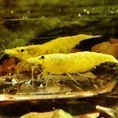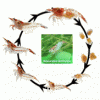Search the Community
Showing results for tags 'Substrate'.
-
It is probably too early to start this but as I have no idea really what I am doing I thought it a good idea to maybe get others thoughts/ideas from the beginning? The aim is to find out if I can reduce the life of the 'buffering' of soil substrates for anyone wanting to use soil substrate with cherry shrimps which do better at higher PH than buffering substrates run, until they are exhausted, and before they get shrimps in the tank - that can't be many people I know??? I set up a betta tank mid March and the buffering with the JBL substrate stopped about 4 months later., though you may be able to knock off a month as I was only doing part (25%) water changes? Obviously no one wants to wait that long so I am just trying this experiment as I have 2L of shrimp king soil left over anyway. that I won't use! At the moment I have put 5L dechlorinated tap water in a bucket with 1L of substrate. The tap water is PH7.5 (KH3, TDS 154) and I am planning to do 50% water changes twice a week until the PH gets back to the 7.5 at which point I can assume it is exhausted? I will then try the same experiment using PH+ to see if that will speed up the process, but I haven't ordered that just yet? Any suggestions, am I doing it correctly, does it even make any sense? So this should give me an idea of how long it will take to stop buffering just using tap water but doing twice weekly 50% water changes, and then whether using PH+ would speed it up notably? This is just to get an idea, and different soil substrates will probably be different so I am not really looking for a definite answer as to the time length etc, more an idea as to whether either of these will work well for others in the future that want to keep cherry shrimp with the soil substrates. Having said that I have always kept cherry shrimp in lower than recommended PH (to start wirh) without a problem anyway? Simon
-
Just received a new Fluval Flex 9 gallon which I'll be using for my Neocardina Davidi var. orange shrimpettes. They are currently in a 1-1/2 gallon vase jarrarium with Aquasolum by Aquavitro substrate, live plants, no heater or filtration. I have leftover Aquasolum substrate which I'm thinking of using again, either as a base substrate with sand or gravel cap or just by itself like I did in the jarrarium. The reason I'm considering a cap is it's difficult to plant in and the cap could help with that. I see Black Diamond sandblasting sand is popular but not eager about buying a 50lb bag and having to store the leftovers. Or, just capping with regular old black gravel from the pet store. I'm leaning towards using it by itself cause I'm not sure how a cap would look on the round Aquasolum pellets plus it is what the shrimp are used to, they were born in the vase. Any suggestions from you pros much appreciated, this is my 1st foray into raising shrimp. Here are some pics of their existing setup: Shrimp Jarrarium Album
-
Hi all, I have to move my tank in about a months time, and want to rescape the tank considering it will already be drained. I want to change the substrate from an inert gravel to ADA amazonia owing to the fact i want to grow some more plants/get a carpet going. I have read online that amazonia will produce amonia for weeks after it's addition to a tank. Not wanting to harm the inhabitants (neons and RCS) i was thinking that i would try and cycle the soil in a separate container first and then add it to the tank, what are people's thoughts on this? The tank is fully cycled (60l) with a ehiem 2215 filter. Thanks in advance for the advice.
-
Hey all I am new to the shrimp thing and am a bit confused by a few things. But first a bit about what I have and want to achieve. I am looking at keeping Crystal Reds and Blacks and as my confidence increases trying for a few different types like Hulks and Blue Bolts and maybe a selective breeding program. I have a cycled rack with 5 tanks ( 4 x 3ft and 1 x 5ft) a common sump (3ft with normal media and a 10000 l/h pump with return so pressure isn't through the roof) and sponge filters for each of the 5 tanks. It has a 300w heater but I am thinking of adding a second 200w just in case of a problem. Will this be ok for the above shrimp or stop the sump and just use the sponges? And now for my newbie questions and things I would like clarified. - Pinto's are a hybrid shrimp of tigers and bees bred for specific patterns or is there something more complicated happening? - Can you have mishlings and end up with a few different bee type shrimp after breeding. ie 2 x mishlings bred and offspring could be KK or Hulk or Panda (or any others) depending on genes? - Can you ever breed true bees from mishlings? - When doing water changes do you gravel vac the substrate or just top up water? - I was planning to have the tanks bare with mosses and plants in pots to help with cleaning will this be ok? - I am using rain water it has a 6.8 PH, 0 KH and I don't have a test kit for TDS and GH is it necessary to have these tests and will I need something to buffer the water and keep the PH lower like ADA soil? - (I have read if KH and PH are low you cannot have a high TDS????) - Can you get Crystal Blues, Greens or Oranges and what is the difference between Pandas and Crystal Black is it just a slight colour difference? Please forgive any obviously silly questions as I have searched a lot on the net and confused myself with different information. I am also wanting to minimise any deaths so have not bought any shrimp yet until I am satisfied I know enough and can achieve what I would like to. Any extra advise would be appreciated thanks for the help and if you need any more information about my setup or anything let me know sorry again if anything seems obvious. Cheers :)
-
Does anyone have recommendations for nice-looking inert black substrate? Looking to use this for future cherry/tiger tanks. NZ iron sand is looking good so far!
-
Hi SKF! I'm hoping to get some advice and opinions on managing pH for a tank with cherries and bee shrimps. My pH is measuring around 5.4 and I'm concerned it may continue to drop over time to unacceptable levels even for bee shrimps. Currently there is only CRS in the tank but I want to add some neos soon. Firstly some background detail - I have a tank with a modest amount of cal aqua labs black earth premium as per the manufacturer's advice. I use RO/DI water (I changed cartridge recently and TDS of RO is zero) with SS GH+. I keep up with regular WC and the TDS is about 140ppm at last check. The tank is heavily planted, has quite a few pieces of driftwood here and there and also some catappa/IAL. There is oodles and oodles of filtration including canister and air driven sponges, and the stocking rate is low-medium. There is some benibachi fulvic grains in the canister (although these fulvic grains are roughly 6 months old and should be close to expiring now; however I will still remove these fulvic grains when I get around to doing some maintenance on the canister however). The shrimp are quite happy and new ones are regularly getting berried. Anyway, so aside from removing the fulvic grains and possibly removing the indian almond leaf, and maybe some of the larger driftwood which may help to prevent the gradual acidification that is going on. I am wondering if anyone has experience using small amounts of aragonite or similar to help buffer the tanks. If anyone has any other suggestion or opinion it will be greatly appreciated. I don't fancy that cherry shrimps will breed very well in pH 5.4 or less and I really do want to keep some different coloured shrimps in this setup! I will be most grateful for any input :-) love n peace will -edit- I should add that it's true that as a last resort if it really comes to it then I could remove some of the substrate but I don't want to pollute the water in this way if I can avoid it..
-
Hi All, I am setting up a new shrimp tank and instead of using fine black gravel want to use a natural substrate. What is the best one to use for RCS. Cheers
-
Can anyone recommend somewhere to get a dark, inert gravel for cherry shrimp? I've got various coloured cherries and rilli's and have had a few deaths. I'm current using fluval stratum, but after discussions with a very competent shrimp keeper I think it could be the substrate that is not agreeing with them. Any suggestions would be greatly appreciated!
-
What substrate do people use and where can I find some! TIA
-
BACKGROUND I have been keeping fish and aquatic plants for nearly 300 years now and have been blessed with a wonderful career in Horticulture. When planted tanks were popularised by the work of Amano, I started looking at various aquarium related forums to see what sort of information was available to hobbyists. It didn't take long to see that most of this was based on the opinions of aquarists who had achieved some success growing plants. Much of it was contradictory and I saw lots of talk about deficiencies, dosing of individual elements, misdiagnosis of problems and expensive mistakes. There didn't seem to be much of an organised approach to growing aquatic plants and there was a real need for reliable answers to the problems facing beginners in the hobby. For me it came to a head when my good friends, Billy and Victor opened Aquaristic Aquarium Gallery. Their mission was to provide top quality products, great customer service, inspiration and of course, to make lots of money. THE REALITY They stocked the best and most popular substrates, amendments, fertilizers, lighting and CO2 injection technology.They also set up display tanks to show their clients what they could expect from the various products in stock. Despite the wonderful results obtained in their shop, it became apparent that there was no simple way to prepare their clients for the problems they would face in the attempt to produce a lovely nature aquarium. One such problem was to find a substrate that could be used by a novice without the pitfalls of ammonia spikes, melting plants, algal blooms and cloudiness when disturbing the substrate. THE ANSWER Billy asked me if it was possible to develop a media he could happily recommend to his clients, confident that they would have a positive experience. I felt sure that with sufficient yelling, name calling and arguing, this could be done. So here we are, 2 years later, well tested by his experienced friends, ready to flood the market with SMARTSOIL. WHAT IS IT? SMARTSOIL is a balanced blend of high quality Clay, Peat, Sand and some secret amendments of my own which do not cause cancer, infertility or death in fish, inverts or humans. SMARTSOIL addresses the problems that can cause headaches, mentioned above. SMARTSOIL is sold in bags of approx 2 litres, sufficient for a standard 60cm tank. HOW DO YOU USE IT? First,you spread the SMARTSOIL evenly over the tank floor, covering only the areas to be planted. If you are very particular, you can spray this layer with a fine mist of water, press it gently and leave it overnight to harden. This step is useful to professionals who cannot afford to risk murky water when they fill a clients tank. Then you spread at least 5cm of the sand or gravel of your choice and carefully fill the tank with water. Unlike other media, you are not obliged to thickly plant your tank from day one. I find it best to simply leave things alone. DO NOT DOSE ANY FERTILIZER FOR AT LEAST A MONTH!! The SMARTSOIL will absorb any excess ammonia during the settling period. It contains enough ferts to support growth for at least a month without burning plants or causing algal blooms. If you wish to move plants around, some clay will be stirred up but the cloudiness will quickly settle. SMARTSOIL is a long term choice and will last longer as an effective media than any of the soils I have trialed. Shrimp friendly too. Thanks for reading AR
-
BACKGROUND I have been keeping fish and aquatic plants for nearly 300 years now and have been blessed with a wonderful career in Horticulture. When planted tanks were popularised by the work of Amano, I started looking at various aquarium related forums to see what sort of information was available to hobbyists. It didn't take long to see that most of this was based on the opinions of aquarists who had achieved some success growing plants. Much of it was contradictory and I saw lots of talk about deficiencies, dosing of individual elements, misdiagnosis of problems and expensive mistakes. There didn't seem to be much of an organised approach to growing aquatic plants and there was a real need for reliable answers to the problems facing beginners in the hobby. For me it came to a head when my good friends, Billy and Victor opened Aquaristic Aquarium Gallery. Their mission was to provide top quality products, great customer service, inspiration and of course, to make lots of money. THE REALITY They stocked the best and most popular substrates, amendments, fertilizers, lighting and CO2 injection technology.They also set up display tanks to show their clients what they could expect from the various products in stock. Despite the wonderful results obtained in their shop, it became apparent that there was no simple way to prepare their clients for the problems they would face in the attempt to produce a lovely nature aquarium. One such problem was to find a substrate that could be used by a novice without the pitfalls of ammonia spikes, melting plants, algal blooms and cloudiness when disturbing the substrate. THE ANSWER Billy asked me if it was possible to develop a media he could happily recommend to his clients, confident that they would have a positive experience. I felt sure that with sufficient yelling, name calling and arguing, this could be done. So here we are, 2 years later, well tested by his experienced friends, ready to flood the market with SMARTSOIL. WHAT IS IT? SMARTSOIL is a balanced blend of high quality Clay, Peat, Sand and some secret amendments of my own which do not cause cancer, infertility or death in fish, inverts or humans. SMARTSOIL addresses the problems that can cause headaches, mentioned above. SMARTSOIL is sold in bags of approx 2 litres, sufficient for a standard 60cm tank. HOW DO YOU USE IT? First,you spread the SMARTSOIL evenly over the tank floor, covering only the areas to be planted. If you are very particular, you can spray this layer with a fine mist of water, press it gently and leave it overnight to harden. This step is useful to professionals who cannot afford to risk murky water when they fill a clients tank. Then you spread at least 5cm of the sand or gravel of your choice and carefully fill the tank with water. Unlike other media, you are not obliged to thickly plant your tank from day one. I find it best to simply leave things alone. DO NOT DOSE ANY FERTILIZER FOR AT LEAST A MONTH!! The SMARTSOIL will absorb any excess ammonia during the settling period. It contains enough ferts to support growth for at least a month without burning plants or causing algal blooms. If you wish to move plants around, some clay will be stirred up but the cloudiness will quickly settle. SMARTSOIL is a long term choice and will last longer as an effective media than any of the soils I have trialed. Shrimp friendly too. Thanks for reading AR View full article
-
One of the biggest headaches for planted tank enthusiasts is choosing the right substrate. There is no 'best' substrate as each has advantages and disadvantages. So let's take a look at what is available. NATURAL SAND AND GRAVEL Inert sand and gravel can make a perfectly good starting point for any aquarist. My favourite quartz sand is from the Nepean River. Never use beach sand, always river sand. Fine rooted plants like Hc and Hairgrass will grow easily in sand. Their roots are able to make a tight grip in sand and in nature, they are usually found growing on the fine, silty edges of creeks and pools. When choosing a gravel, go for a grain size around 2-4mm as this will allow roots to grow freely and also allow water to circulate through the root zone. Quartz gravel is a good choice for people wanting to use Undergravel filters as it will not break down over time and clog the filter. Baby fish and shrimp will not get caught in these filters and cleaning with a gravel filter then topping with clean water achieves a water change and filter clean at the same time. Amendments such as Laterite are also suitable to provide food directly to the roots. The addition of Marble Chip will help avoid problems with Vallisneria, Swordplants, Aponogetons and most of the Cryptocorynes. If you are planning to use only Mosses and Ferns, Natural Gravel is possibly the best choice. MANUFACTURED SUBSTRATES These are designed to provide a good media for heavily planted tanks. When you choose a brand of soil, I suggest you stick with the same brand of amendments and fertilizers since these are designed to compliment the substrate. People using these substrates will often spend a lot of time dosing, testing and adjusting their tanks. Good lighting and CO2 injection are necessary to achieve the best results. DIY SUBSTRATES Many people these days like to mix their own substrates. Diana Walstad has written articles and books with her findings on home made mixes. Well worth reading her material if you want to have a go. There is also a trend for some of the better aquarium outlets to provide their own specialty mix. One of these is SMARTSOIL, designed by aquarists to make planted tanks easy. SMARTSOIL will help prevent ammonia spike during set-up and contains a flocculant to avoid cloudy water when disturbing the substrate. I welcome comments and positive input to the comments I have made here. AR
-

New Library Article - A look at planted tank substrates
Anthony Rae posted a topic in Anything Forum Related
One of the biggest headaches for planted tank enthusiasts is choosing the right substrate. There is no 'best' substrate as each has advantages and disadvantages. So let's take a look at what is available. NATURAL SAND AND GRAVEL Inert sand and gravel can make a perfectly good starting point for any aquarist. My favourite quartz sand is from the Nepean River. Never use beach sand, always river sand. Fine rooted plants like Hc and Hairgrass will grow easily in sand. Their roots are able to make a tight grip in sand and in nature, they are usually found growing on the fine, silty edges of creeks and pools. When choosing a gravel, go for a grain size around 2-4mm as this will allow roots to grow freely and also allow water to circulate through the root zone. Quartz gravel is a good choice for people wanting to use Undergravel filters as it will not break down over time and clog the filter. Baby fish and shrimp will not get caught in these filters and cleaning with a gravel filter then topping with clean water achieves a water change and filter clean at the same time. Amendments such as Laterite are also suitable to provide food directly to the roots. The addition of Marble Chip will help avoid problems with Vallisneria, Swordplants, Aponogetons and most of the Cryptocorynes. If you are planning to use only Mosses and Ferns, Natural Gravel is possibly the best choice. MANUFACTURED SUBSTRATES These are designed to provide a good media for heavily planted tanks. When you choose a brand of soil, I suggest you stick with the same brand of amendments and fertilizers since these are designed to compliment the substrate. People using these substrates will often spend a lot of time dosing, testing and adjusting their tanks. Good lighting and CO2 injection are necessary to achieve the best results. DIY SUBSTRATES Many people these days like to mix their own substrates. Diana Walstad has written articles and books with her findings on home made mixes. Well worth reading her material if you want to have a go. There is also a trend for some of the better aquarium outlets to provide their own specialty mix. One of these is SMARTSOIL, designed by aquarists to make planted tanks easy. SMARTSOIL will help prevent ammonia spike during set-up and contains a flocculant to avoid cloudy water when disturbing the substrate. I welcome comments and positive input to the comments I have made here. AR View full article




